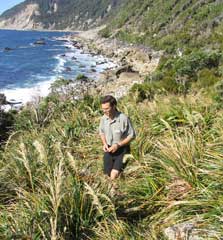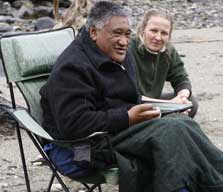
Checking for invasive weeds
The over-arching goal of the Fiordland Islands Restoration Programme is to remove significant pest species (largely stoats, deer, and rodents) from islands in Fiordland, and to reintroduce threatened species formally present within the region.
Part of this goal is to maintain a high level of control and monitoring for these and other pest species including pest-plants.
Restoration and operational plans have been produced for key islands, including:
- Coal Island (Te Puka-Hereka) Restoration Plan, Derek Brown, September 2013 (PDF, 677K)
- Secretary Island Operational Plan - Stoat Eradication (PDF, 1,060K)
- Secretary Island Deer Scoping Document (PDF, 397K)
- Secretary Island Deer Eradication Plan (PDF, 305K)
- Resolution Island Operational Plan - Stoat Eradication (PDF, 9,838K)
- Secretary and Resolution Islands Restoration Plan (Draft 2008). Prepared by Chrissy Wickes and Kerri-Anne Edge, Department of Conservation
- Anchor Island Restoration Plan (2002). Prepared by Hannah Edmonds, Department of Conservation
- Anchor Island Deer Control Plan (2003). Prepared by Mark Mawhinney, Department of Conservation
- Stoat Eradication Operation - Te Puka Hereka, "The Tied Anchor", Preservation Ark, Coal Island (2005). Prepared for the Trust by Erina Loe, Department of Conservation
- Chalky Island: stoat eradication and reconnaissance trip (1998). Prepared by Murray Willans and Daryl Eason, Department of Conservation
- A Pest Management Plan for Te Puka-Hereka (Coal Island) (2005). Prepared by Derek Brown (Conservation Contractor)
- A Pest Management Plan for Pomona and Rona Islands, Lake Manapouri (2006). Prepared by Derek Brown
- Restoration Plan: Pomona and Rona Islands, Pomona Island Charitable Trust (2008). Viv Shaw and D. John Whitehead, Pomona Island Charitable Trust
Integrated management

Phil Crown, Kaumatua for Ngati Rereahu,
at release of North Island kokako
Islands provide sites where integrated biodiversity management is often more cost effective than on the mainland, due to reduced numbers and types of pests, and lower reinvasion rates.
Pests targeted in DOC’s programme include rats, stoats and deer. Eradication (the removal of the resident pest populations and the establishment of long-term control programmes to manage re-invasion) is preferred to ongoing control of pest mammals (see Project Implementation).
The methods put in place for the eradication operations are the same as those used to undertake long-term control and to reduce the risk of reinvasion from the mainland.
Rodent eradications are planned as one-off operations where the only on-going commitment is to prevent re-establishment through effective island quarantine measures and monitoring.
DOC-managed projects involve stakeholders in planning through public talks and annual workshops with local tourist operators. Iwi are consulted throughout the planning process with regard to infrastructure set-up, pest eradication, and species transfers.
Community-driven programmes are undertaken in consultation with DOC, and the wider community. For aerial poison operations for rodent eradications, a Resource Consent is required from the Regional Council (publically notified) and a Medical Officer of Health Consent from the Regional Public Health Authority.